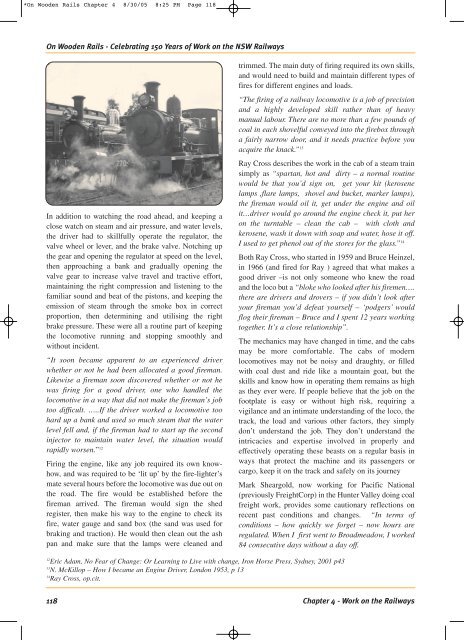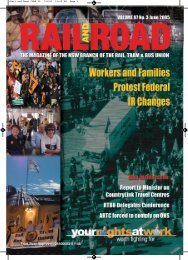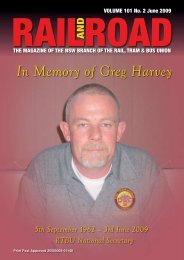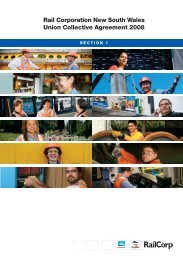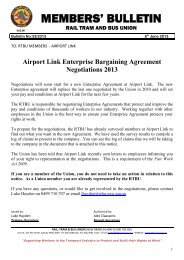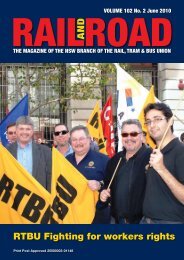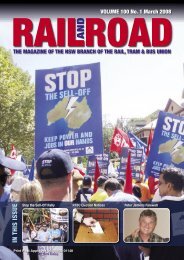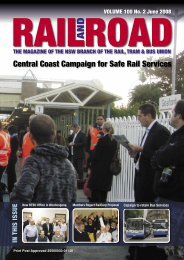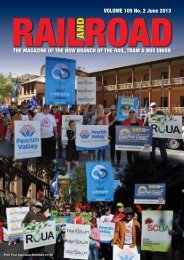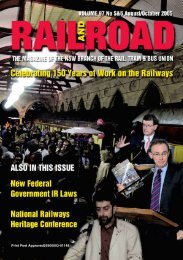Chapter 4 - Work on the Railways - Rail, Tram and Bus Union of NSW
Chapter 4 - Work on the Railways - Rail, Tram and Bus Union of NSW
Chapter 4 - Work on the Railways - Rail, Tram and Bus Union of NSW
Create successful ePaper yourself
Turn your PDF publications into a flip-book with our unique Google optimized e-Paper software.
*On Wooden <strong>Rail</strong>s <str<strong>on</strong>g>Chapter</str<strong>on</strong>g> 4 8/30/05 8:25 PM Page 118<br />
On Wooden <strong>Rail</strong>s - Celebrating 150 Years <strong>of</strong> <str<strong>on</strong>g>Work</str<strong>on</strong>g> <strong>on</strong> <strong>the</strong> <strong>NSW</strong> <strong><strong>Rail</strong>ways</strong><br />
In additi<strong>on</strong> to watching <strong>the</strong> road ahead, <strong>and</strong> keeping a<br />
close watch <strong>on</strong> steam <strong>and</strong> air pressure, <strong>and</strong> water levels,<br />
<strong>the</strong> driver had to skillfully operate <strong>the</strong> regulator, <strong>the</strong><br />
valve wheel or lever, <strong>and</strong> <strong>the</strong> brake valve. Notching up<br />
<strong>the</strong> gear <strong>and</strong> opening <strong>the</strong> regulator at speed <strong>on</strong> <strong>the</strong> level,<br />
<strong>the</strong>n approaching a bank <strong>and</strong> gradually opening <strong>the</strong><br />
valve gear to increase valve travel <strong>and</strong> tractive effort,<br />
maintaining <strong>the</strong> right compressi<strong>on</strong> <strong>and</strong> listening to <strong>the</strong><br />
familiar sound <strong>and</strong> beat <strong>of</strong> <strong>the</strong> pist<strong>on</strong>s, <strong>and</strong> keeping <strong>the</strong><br />
emissi<strong>on</strong> <strong>of</strong> steam through <strong>the</strong> smoke box in correct<br />
proporti<strong>on</strong>, <strong>the</strong>n determining <strong>and</strong> utilising <strong>the</strong> right<br />
brake pressure. These were all a routine part <strong>of</strong> keeping<br />
<strong>the</strong> locomotive running <strong>and</strong> stopping smoothly <strong>and</strong><br />
without incident.<br />
“It so<strong>on</strong> became apparent to an experienced driver<br />
whe<strong>the</strong>r or not he had been allocated a good fireman.<br />
Likewise a fireman so<strong>on</strong> discovered whe<strong>the</strong>r or not he<br />
was firing for a good driver, <strong>on</strong>e who h<strong>and</strong>led <strong>the</strong><br />
locomotive in a way that did not make <strong>the</strong> fireman’s job<br />
too difficult. …..If <strong>the</strong> driver worked a locomotive too<br />
hard up a bank <strong>and</strong> used so much steam that <strong>the</strong> water<br />
level fell <strong>and</strong>, if <strong>the</strong> fireman had to start up <strong>the</strong> sec<strong>on</strong>d<br />
injector to maintain water level, <strong>the</strong> situati<strong>on</strong> would<br />
rapidly worsen.” 12<br />
Firing <strong>the</strong> engine, like any job required its own knowhow,<br />
<strong>and</strong> was required to be ‘lit up’ by <strong>the</strong> fire-lighter’s<br />
mate several hours before <strong>the</strong> locomotive was due out <strong>on</strong><br />
<strong>the</strong> road. The fire would be established before <strong>the</strong><br />
fireman arrived. The fireman would sign <strong>the</strong> shed<br />
register, <strong>the</strong>n make his way to <strong>the</strong> engine to check its<br />
fire, water gauge <strong>and</strong> s<strong>and</strong> box (<strong>the</strong> s<strong>and</strong> was used for<br />
braking <strong>and</strong> tracti<strong>on</strong>). He would <strong>the</strong>n clean out <strong>the</strong> ash<br />
pan <strong>and</strong> make sure that <strong>the</strong> lamps were cleaned <strong>and</strong><br />
118<br />
trimmed. The main duty <strong>of</strong> firing required its own skills,<br />
<strong>and</strong> would need to build <strong>and</strong> maintain different types <strong>of</strong><br />
fires for different engines <strong>and</strong> loads.<br />
“The firing <strong>of</strong> a railway locomotive is a job <strong>of</strong> precisi<strong>on</strong><br />
<strong>and</strong> a highly developed skill ra<strong>the</strong>r than <strong>of</strong> heavy<br />
manual labour. There are no more than a few pounds <strong>of</strong><br />
coal in each shovelful c<strong>on</strong>veyed into <strong>the</strong> firebox through<br />
a fairly narrow door, <strong>and</strong> it needs practice before you<br />
acquire <strong>the</strong> knack.” 13<br />
Ray Cross describes <strong>the</strong> work in <strong>the</strong> cab <strong>of</strong> a steam train<br />
simply as “spartan, hot <strong>and</strong> dirty – a normal routine<br />
would be that you’d sign <strong>on</strong>, get your kit (kerosene<br />
lamps ,flare lamps, shovel <strong>and</strong> bucket, marker lamps),<br />
<strong>the</strong> fireman would oil it, get under <strong>the</strong> engine <strong>and</strong> oil<br />
it…driver would go around <strong>the</strong> engine check it, put her<br />
<strong>on</strong> <strong>the</strong> turntable – clean <strong>the</strong> cab – with cloth <strong>and</strong><br />
kerosene, wash it down with soap <strong>and</strong> water, hose it <strong>of</strong>f.<br />
I used to get phenol out <strong>of</strong> <strong>the</strong> stores for <strong>the</strong> glass.” 14<br />
Both Ray Cross, who started in 1959 <strong>and</strong> Bruce Heinzel,<br />
in 1966 (<strong>and</strong> fired for Ray ) agreed that what makes a<br />
good driver –is not <strong>on</strong>ly some<strong>on</strong>e who knew <strong>the</strong> road<br />
<strong>and</strong> <strong>the</strong> loco but a “bloke who looked after his firemen….<br />
<strong>the</strong>re are drivers <strong>and</strong> drovers – if you didn’t look after<br />
your fireman you’d defeat yourself – ‘podgers’ would<br />
flog <strong>the</strong>ir fireman – Bruce <strong>and</strong> I spent 12 years working<br />
toge<strong>the</strong>r. It’s a close relati<strong>on</strong>ship”.<br />
The mechanics may have changed in time, <strong>and</strong> <strong>the</strong> cabs<br />
may be more comfortable. The cabs <strong>of</strong> modern<br />
locomotives may not be noisy <strong>and</strong> draughty, or filled<br />
with coal dust <strong>and</strong> ride like a mountain goat, but <strong>the</strong><br />
skills <strong>and</strong> know how in operating <strong>the</strong>m remains as high<br />
as <strong>the</strong>y ever were. If people believe that <strong>the</strong> job <strong>on</strong> <strong>the</strong><br />
footplate is easy or without high risk, requiring a<br />
vigilance <strong>and</strong> an intimate underst<strong>and</strong>ing <strong>of</strong> <strong>the</strong> loco, <strong>the</strong><br />
track, <strong>the</strong> load <strong>and</strong> various o<strong>the</strong>r factors, <strong>the</strong>y simply<br />
d<strong>on</strong>’t underst<strong>and</strong> <strong>the</strong> job. They d<strong>on</strong>’t underst<strong>and</strong> <strong>the</strong><br />
intricacies <strong>and</strong> expertise involved in properly <strong>and</strong><br />
effectively operating <strong>the</strong>se beasts <strong>on</strong> a regular basis in<br />
ways that protect <strong>the</strong> machine <strong>and</strong> its passengers or<br />
cargo, keep it <strong>on</strong> <strong>the</strong> track <strong>and</strong> safely <strong>on</strong> its journey<br />
Mark Sheargold, now working for Pacific Nati<strong>on</strong>al<br />
(previously FreightCorp) in <strong>the</strong> Hunter Valley doing coal<br />
freight work, provides some cauti<strong>on</strong>ary reflecti<strong>on</strong>s <strong>on</strong><br />
recent past c<strong>on</strong>diti<strong>on</strong>s <strong>and</strong> changes. “In terms <strong>of</strong><br />
c<strong>on</strong>diti<strong>on</strong>s – how quickly we forget – now hours are<br />
regulated. When I first went to Broadmeadow, I worked<br />
84 c<strong>on</strong>secutive days without a day <strong>of</strong>f.<br />
12 Eric Adam, No Fear <strong>of</strong> Change: Or Learning to Live with change, Ir<strong>on</strong> Horse Press, Sydney, 2001 p43<br />
13 N. McKillop – How I became an Engine Driver, L<strong>on</strong>d<strong>on</strong> 1953, p 13<br />
14 Ray Cross, op.cit.<br />
<str<strong>on</strong>g>Chapter</str<strong>on</strong>g> 4 - <str<strong>on</strong>g>Work</str<strong>on</strong>g> <strong>on</strong> <strong>the</strong> <strong><strong>Rail</strong>ways</strong>


